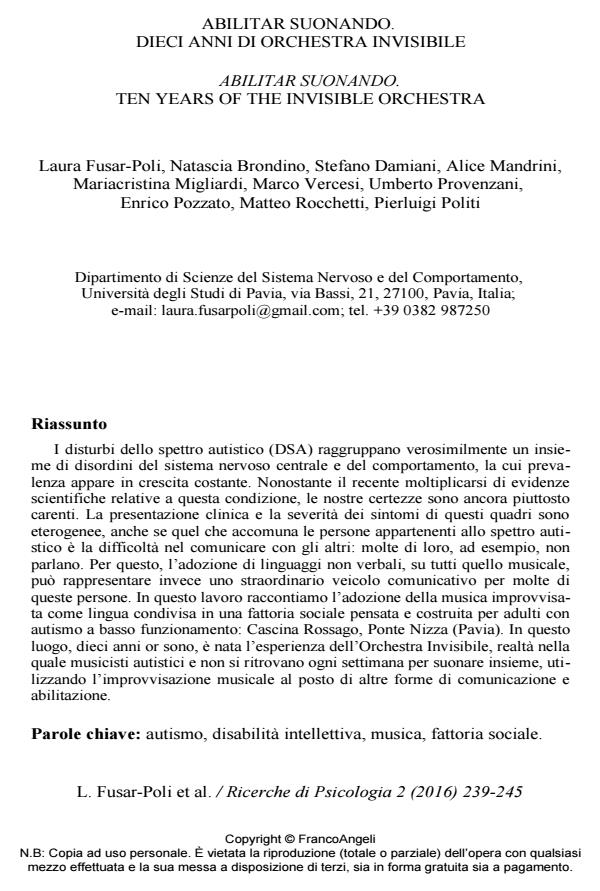Abilitar suonando. Ten years of the invisible orchestra
Journal title RICERCHE DI PSICOLOGIA
Author/s Laura Fusar-Poli, Natascia Brondino, Stefano Damiani, Alice Mandrini, Mariacristina Migliardi, Marco Vercesi, Umberto Provenzani, Enrico Pozzato, Matteo Rocchetti, Pierluigi Politi
Publishing Year 2016 Issue 2016/2
Language Italian Pages 7 P. 239-245 File size 157 KB
DOI 10.3280/RIP2016-002008
DOI is like a bar code for intellectual property: to have more infomation
click here
Below, you can see the article first page
If you want to buy this article in PDF format, you can do it, following the instructions to buy download credits

FrancoAngeli is member of Publishers International Linking Association, Inc (PILA), a not-for-profit association which run the CrossRef service enabling links to and from online scholarly content.
Autism spectrum disorders (ASD) represent a series of neurodevelopmental conditions whose prevalence has been increasing in the last few years. Despite the recent proliferation of scientific evidence concerning the autistic spectrum, our certainties are still somewhat lacking. Clinical presentation and symptoms severity of these disorders are heterogeneous, but people who belong to the autistic spectrum share the same difficulties in communication: for example, many of them don’t speak at all. The use of non-verbal languages – music above all – may represent an extraordinary communication vehicle for these people. According to this principle, music is the language shared every week in Cascina Rossago, the first Italian farm-community specifically thought and built for people with low-functioning ASD. The experience of the Invisible Orchestra was born ten years ago in Cascina Rossago, where autistic and neurotypical musicians meet every week in order to play together, using musical improvisation instead of other communication and rehabilitation models.
Keywords: Autism, intellectual disability, music, farm-community.
- Brain and Heart Dynamics Laura Fusar-Poli, Cecilia Guiot, pp.1 (ISBN:978-3-319-90305-7)
- Brain and Heart Dynamics Laura Fusar-Poli, Cecilia Guiot, pp.891 (ISBN:978-3-030-28007-9)
Laura Fusar-Poli, Natascia Brondino, Stefano Damiani, Alice Mandrini, Mariacristina Migliardi, Marco Vercesi, Umberto Provenzani, Enrico Pozzato, Matteo Rocchetti, Pierluigi Politi, Abilitar suonando. Dieci anni di orchestra invisibile in "RICERCHE DI PSICOLOGIA " 2/2016, pp 239-245, DOI: 10.3280/RIP2016-002008